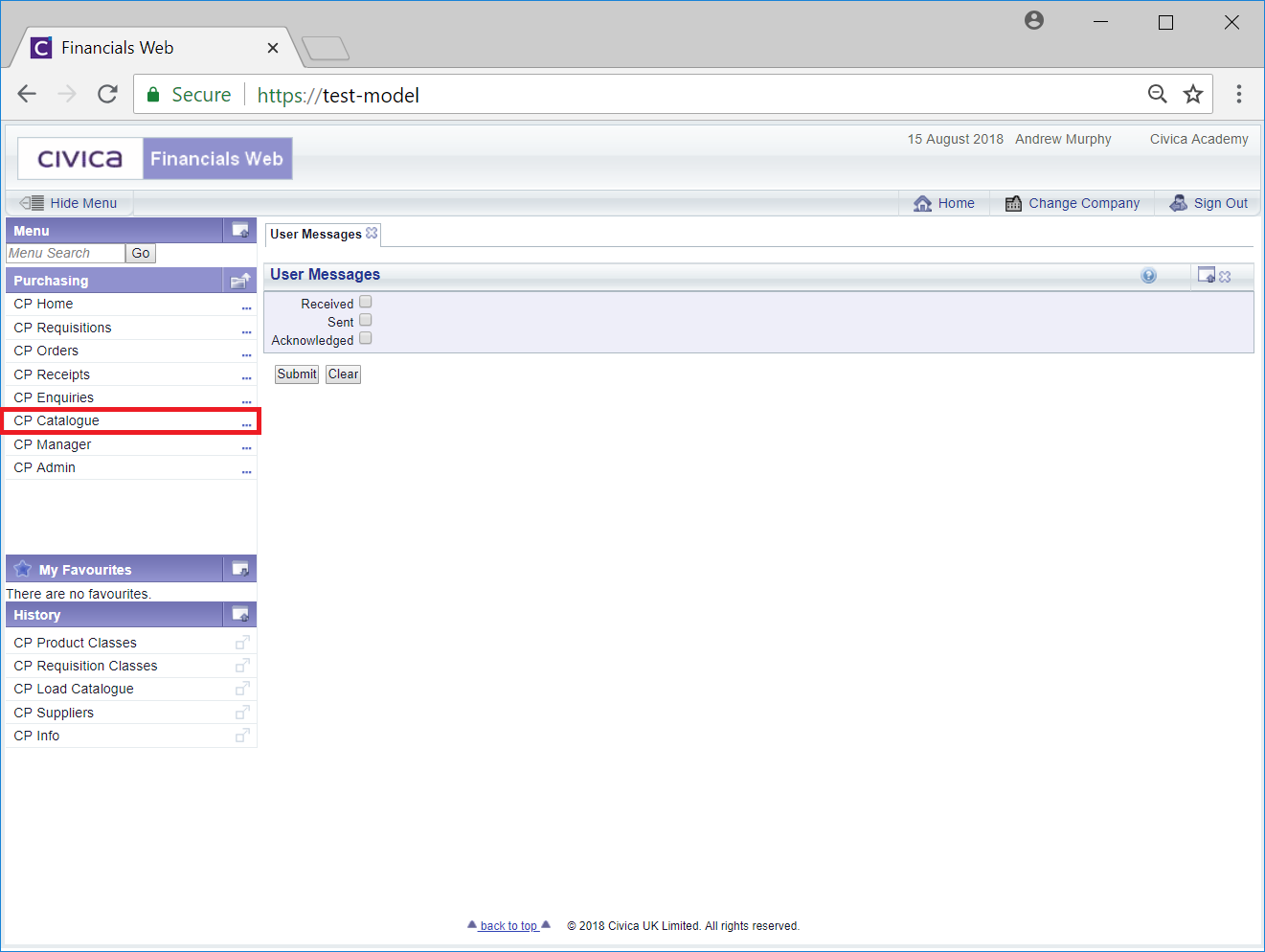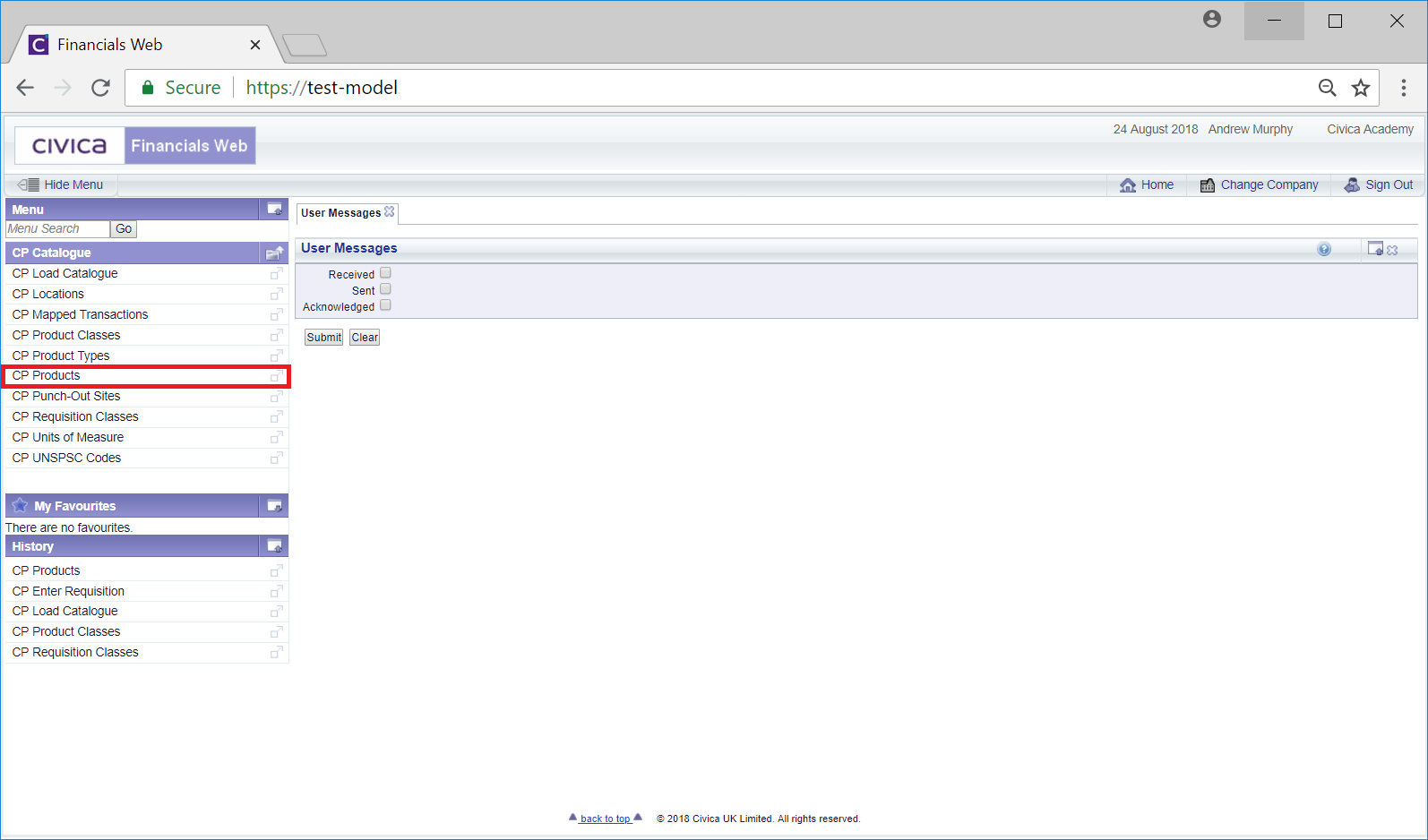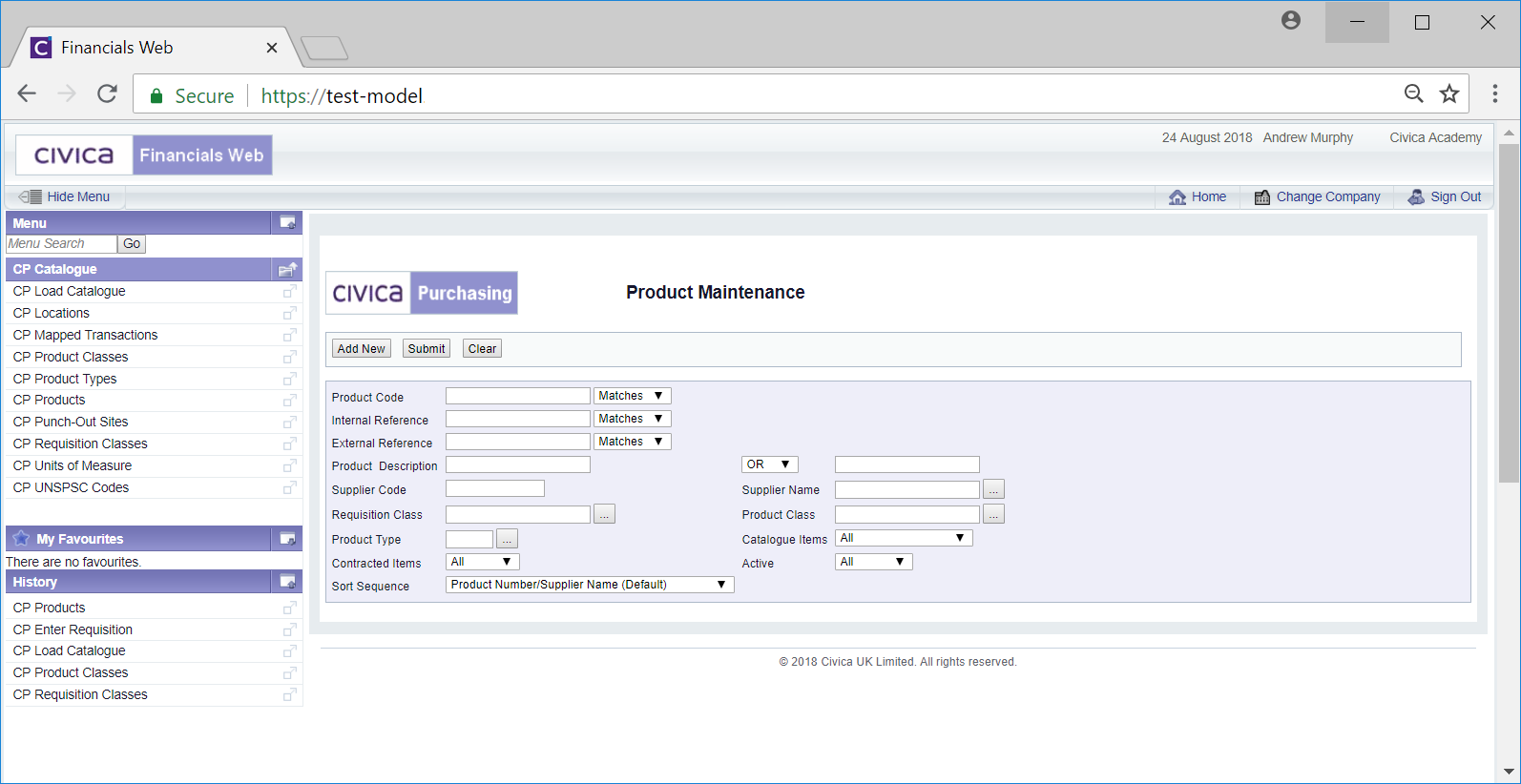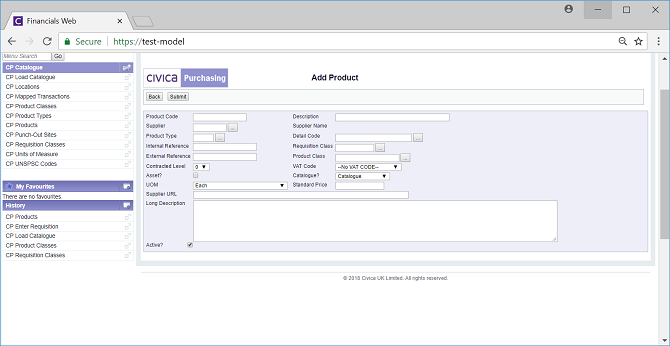Products are created in the Edit Product screen, which be accessed by clicking on the CP Catalogue Menu option in the Purchasing menu:

Then selecting the CP Products Maintenance menu option:

The Products Maintenance form will open:

Clicking on the  button.
button.
The Add Product form will then be displayed:

The fields and options on this form are:
- Product Code: Add a code for the Product.
- Description: Add a description for the Product.
- Supplier: Add the Supplier's reference. Alternatively click on the Find Supplier button, which is located at the end of the field,
 . This will open the Supplier Search form that will allow you to search for and select the required Supplier. This form is further detailed in the Supplier Search section. Once selected the Supplier reference will be added to this field and the name of the Supplier will be added to the Supplier Name field.
. This will open the Supplier Search form that will allow you to search for and select the required Supplier. This form is further detailed in the Supplier Search section. Once selected the Supplier reference will be added to this field and the name of the Supplier will be added to the Supplier Name field.
- Product Type: Please ignore this field as this functionality is not currently being used.
- Detail Code: Add a Detail Code if required. Alternatively click on the Find Detail Code button, which is located at the end of the field,
 . This will open the Find Detail Code form that will allow you to search for and select the required Detail Code. This form is further detailed in the Find Detail Code section. Once selected the Detail Code will be added to this field.
. This will open the Find Detail Code form that will allow you to search for and select the required Detail Code. This form is further detailed in the Find Detail Code section. Once selected the Detail Code will be added to this field.
This Detail Code will be used as the default Detail Code when the Product is added to a Requisition, at which point it can be changed if required,
If no Detail Code is added to the Product then the Detail Code on the associated Product Class will be used when the Product is added to a Requisition, at which point it can be changed if required.
Where both the Product and the associated Product Class has a Detail Code, the Detail Code on the Product will be used.
- Internal Reference: This field is utilised when Catalogue Products are imported, as detailed in the Importing Catalogue Products section. For other Products this field can be used to include an internal reference that will further identify the Product.
- Requisition Class: Add the Requisition Class that the Product is to be associated with to this field. Alternatively click on the Find Requisition Class button, which is located at the end of the field,
 . This will open the Find Requisition Class form that will allow you to search for and select the required Requisition Class. This form is further detailed in the Find Requisition Class section. Once selected the Requisition Class will be added to this field.
. This will open the Find Requisition Class form that will allow you to search for and select the required Requisition Class. This form is further detailed in the Find Requisition Class section. Once selected the Requisition Class will be added to this field.
- External Reference: Add an external reference, if required, by which the Product may be further identified.
- Product Class: Add the Product Class that is to be associated with the Product. Please note: the Product Class added must be associated with the Requisition Class that has been added to the Requisition Class field above, otherwise an error message will be displayed.
Alternatively click on the Find Product Class button, which is located at the end of the field,  . This will open the Find Product Class form that will allow you to search for and select the required Product Class. This form is further detailed in the Find Product Class section. Once selected the Product Class will be added to this field.
. This will open the Find Product Class form that will allow you to search for and select the required Product Class. This form is further detailed in the Find Product Class section. Once selected the Product Class will be added to this field.
- Contracted Level: Please ignore this field as the functionality is not being used.
- VAT Code: Select a VAT code from this drop-down list if you want the Product to be associated with a VAT Code. This VAT Code will be used when the Product is added to a Requisition. If no VAT Code is added to the Product, the VAT Code on the associated Product Class will be used when the Product is added to a Requisition.
- Asset?: Please ignore this option as the functionality is not currently being used.
- Catalogue?: The options in this drop-down field are Catalogue, Non-Standard or Template Product, with the default option being Catalogue.
The Catalogue option will include the Product as a Catalogue Product when adding the Product to a Requisition. Adding Catalogue Products to a Requisition is further detailed in the Catalogue Products section.
The Non-Standard option will include the Product as Non-Standard Product when adding the Product to a Requisition. Adding Non-Standard Products to a Requisition is further detailed in the Add Existing Non-Standard Products section.
The Template Product option will allow you to create the Product as a template from which other similar Products can be created.
- UOM: The Unit of Measure for the Product displayed in this drop-down field will default to the Each option but can be changed as required This will be the default Unit of Measure used when the Product is added to a Requisition and can be changed at this point if required unless the Product is a Catalogue Product in which case it cannot be changed.
- Standard Price: A standard price may be included in this field for the Unit of Measure that has been added to the UOM field. This will be the default price when the Product is added to a Requisition and be changed at that point if required. unless the Product is a Catalogue Product in which case it cannot be changed.
- Supplier URL: This field can be used to include the web page of the Product on the Suppliers website giving you direct access to the details of the Product
- Long Description: This will be populated with the details added to the Description field as detailed above. The details in this text box can be amended if required
- Active: This option will be selected if the Product is available to be added to a Requisition. If deselected the Product will not be available. This option can be changed if required.



![]() button.
button.
![]() . This will open the Find Product Class form that will allow you to search for and select the required Product Class. This form is further detailed in the Find Product Class section. Once selected the Product Class will be added to this field.
. This will open the Find Product Class form that will allow you to search for and select the required Product Class. This form is further detailed in the Find Product Class section. Once selected the Product Class will be added to this field.